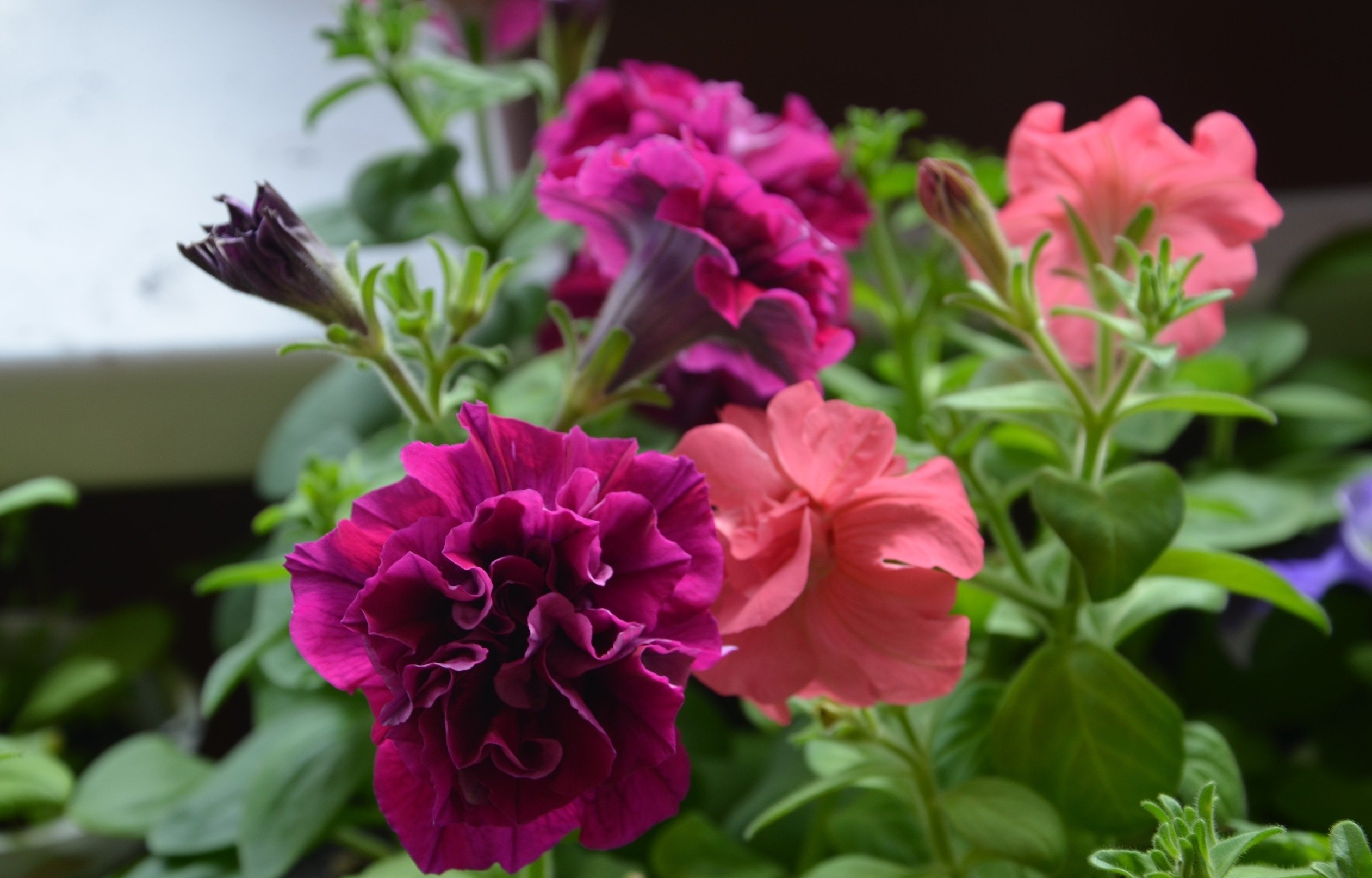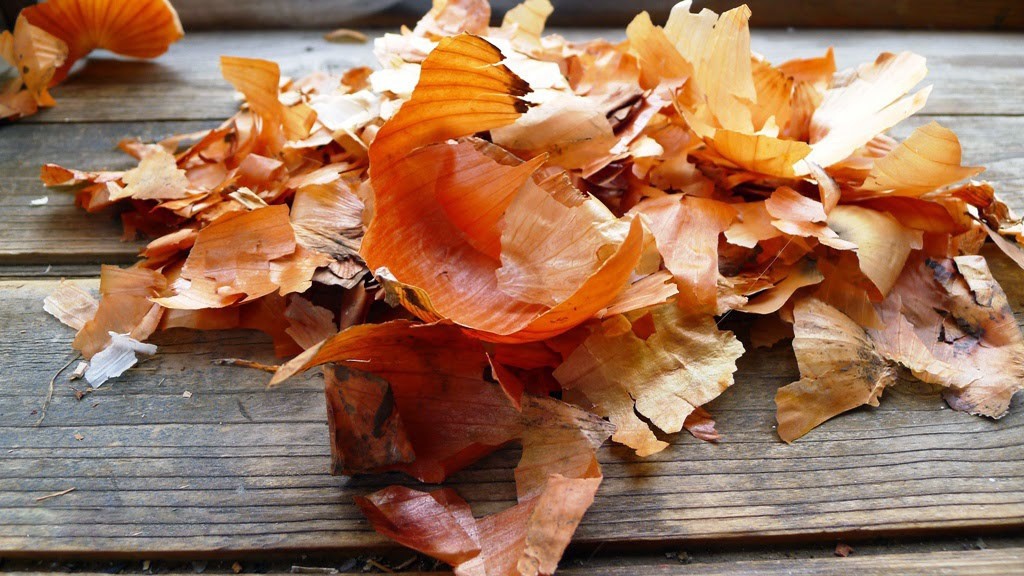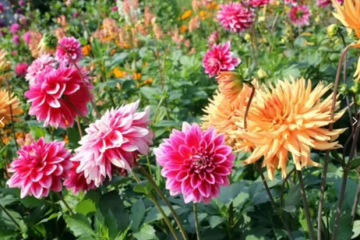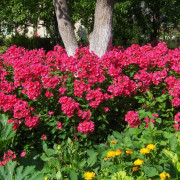How to feed petunia for abundant flowering
Content:
Beautiful annuals of petunias are a favorite decoration of flowerpots, flower beds, balconies, paths in gardens. A rich palette of colors allows you to get amazing combinations and plant flowers in the form of multi-color ornaments and even paintings. The only thing that should not be forgotten is the timely application of fertilizers, without which these flowers will lose the lion's share of their attractiveness.
Brief description of petunias
Herbaceous or semi-shrub, often ampelous flower - petunia (Latin Petunia) belongs to the Solanaceae family (Latin Solanaceae). Most often this plant is undersized up to 20 cm high, but there are also higher varieties (up to 70 cm). Large flowers (up to 15 cm in diameter) on short stalks are simple and double. After pollination, numerous small seeds ripen in capsules.
Why you need to fertilize
Feeding petunias for flowering is required throughout the growing season. The peculiarity of the plant is that new buds bloom almost daily. This requires a high consumption of nutrients.
What will happen if you do not fertilize or do it in excess of the norm
Incorrect fertilization can have negative consequences for the plant. If the dressing was applied in excess, then this will result in a burn of the root system. In the worst case, the flower will die.
Lack of top dressing will result in a reduction in the number of blossoming buds. Some very hardy varieties can do without fertilization, but then their flowers will be smaller than their usual size, and the amount will be less than the expected rate.
How to feed petunia for abundant flowering
There are many preparations on sale that are suitable for feeding petunias. All of them are divided into three categories: mineral (monopreparations), organic and complex. Produced in the form:
- dry powders intended for dilution in water;
- liquid solutions added to water during irrigation;
- long-playing granules that dissolve for a long time on the soil surface with each watering.
Mineral
Calcium or ammonium nitrate is necessary for petunia from the moment the first shoots appear. It provides the plant with the nitrogen it needs for rapid growth. The dilution rate of ammonium nitrate to obtain a working solution is 3-4 g of dry matter per 1 liter of water, and it can only be used for irrigation (not spraying). Calcium nitrate is used for foliar dressing (spraying) from a seedling age of 1.5-2 weeks. The drug is diluted with water in a proportion of 2 g per 1 liter. Urea is analogous to nitrogen nitrate, but more concentrated; it is used for acute nitrogen deficiency (very pale leaves).
The drug nitroammofosk is used to feed well-formed seedling bushes (more than 3-4 pairs of true leaves). A working solution for irrigation is prepared as follows: 2 g of powder or granules are dissolved in 1 liter of water.
Potassium monophosphate (monopotassium phosphate) is an easily soluble substance traditionally used to stimulate the growth of side shoots in petunias and buds. It is introduced when the plant enters the active flowering phase, that is, after planting seedlings in open ground. Consumption: 7-10 g of granules per 10 liters of water.
Double superphosphate is a fertilizer with a predominant proportion of phosphorus. Used to enrich the soil with nutrients. Petunias need it at the time of transplanting seedlings into open ground. Pour 1/4 teaspoon into the planting holes, mixing with the soil.
Organic
This broad group of feeds has a complex chemical composition, but provides all the nutrients that plants need in the most easily digestible form. Organic fertilizers useful for petunias include:
- Rotted cow dung is used in the summer, it is laid out on top of the soil to prevent it from drying out and nourish the roots of petunias. When watering, some of the substances will penetrate into the ground, but you can also specially dilute the mullein with water in a bucket, and then water the flowers with infusion.
- Humus - plant residues that have been exposed to natural rotting in the open air for two years. It is absolutely safe for all groups of plants, does not contain harmful microflora. It can be used in any quantity to enrich the soil and improve its structure.
- Poultry manure contains a lot of nitrogen, so it is diluted with water in a proportion of at least 1:15 and is used for irrigation, but not more often than once a month.
- Ash from burning plants contains manganese, boron, magnesium and other trace elements. It is introduced into the soil before planting seedlings.
- Vermicompost - a substance produced by earthworms, is a complex organic fertilizer suitable for all garden crops and most flower crops.
- Peat is a not very nutrient-rich natural fertilizer with valuable qualities: the ability to increase the acidity of alkaline soils and improve their structure.
Complex
This group of drugs can be used at all stages of plant development. Those who want to be guaranteed to see flowering in early June, and not wait until July, use modern multi-component feeding.
The choice of fertilizer is determined by the season and condition of the petunias:
- The first spring top dressing for the second week after germination (a couple of days after picking) is carried out with a preparation in which nitrogen predominates, and phosphorus and iron are present as additional components. It is difficult to find such a composition in dry form, so a liquid agent is selected, for example, "Kemira Lux", "Oracle Multicomplex" and others.
- The second feeding is carried out after another two weeks, and it can be done by spraying or watering. For this purpose, a complex preparation "Crystalon Green" in a chelated form is suitable, which dissolves in water in a proportion of 10 g of powder per 10 liters of water.
- After transplanting into open ground three times a month (every 10 days) to increase the number of flowers, watering is performed with a solution of "Kristalon Golubiy", "Aquarium Flower" or another complex preparation in which the potassium component prevails in the NPK formula (nitrogen-phosphorus-potassium), and phosphoric and nitrogenous is much less. For example, the formula "Aquarium Flower" NPK = 13% + 5% + 25%.
- To increase the size of the buds and the brightness of the petals, to speed up their appearance will help foliar feeding with concentrated preparations, for example, "Zircon", in which the immunostimulating effect is due to the content of Echinacea purpurea extract. 1 ml of "Zircon" must be dissolved in 1 liter of water.
Folk remedies
There are many recipes for fertilizing petunia. Each gardener has his own. Of these, the following are time-tested:
- Infusion of nettle. The solution is used for spraying the aboveground parts of plants. For its preparation, a bucket with a volume of 10 liters is 2/3 filled with chopped nettle and filled with water. The ready-to-use concentrate will be ready in a week, and it must be diluted by half with water before spraying.
- Sleeping coffee grounds or tea leaves - these are suitable for mulching the soil near petunias outdoors. By mixing with the soil during loosening and watering, tea and coffee release valuable nutrients into the soil.
- Onion tincture - it is prepared from the husk. 20 g of dry husk is poured into 4 liters of boiling water and left to infuse warm for 4 days. Watering is carried out as usual, diluting the concentrate with water 2 times.
- Homemade yeast - suitable for activating the microflora in the soil. Dry ones are diluted in warm water and an hour later used for irrigation. This recipe is only suitable for humus-rich soils.
How to fertilize correctly
Correctly applied top dressing will bring the greatest benefit to petunias, since in case of mistakes there is a high risk of burning the roots and leaves.
Root dressing
The selected mineral, organic or complex preparation must be thoroughly diluted with clean water in the proportion indicated by the manufacturer. Such feeding of petunias for lush flowering will quickly bring a positive effect that is noticeable to the naked eye.
Ready solutions are not stored. They must be prepared in the required amount and water the plants immediately. For dilution, use only plastic containers specially designed for these purposes in order to avoid any reaction of the solution with the walls of a bucket or other container.
Foliar dressing
Liquid fertilizer for petunias for abundant flowering can be applied not by watering, but by spraying. This method is good in that the nutrients are immediately absorbed by the leaves and sent to growth and development. When watering, part of the fertilizer remains in the soil, that is, it is wasted.
The drug Ferovit has proven itself well, helping to compensate for the lack of iron, to which petunias are very sensitive. It is recommended to perform 3-4 treatments at intervals of 3 days.
For spraying solutions, specialized fine spray guns are used, which can be purchased at garden stores. They have different capacities and allow the spray to be directed precisely in the direction of the plant.
Feeding petunias when planting
Seedlings are planted in pre-prepared and fertilized soil. Wood ash, peat, humus are well suited for these purposes. You can add a little superphosphate (consumption - 40 g per 1 sq. M). Plants are planted and watered with boric acid solution, which promotes active distillation of buds. The powder is diluted in a proportion of 2 g per 10 liters of water.
Next, you should feed the petunias after 7-10 days with nitrogen fertilizer, and after another 2 weeks with a complex mineral, organic or phosphorus-potassium fertilizer.
Fertilizing during flowering
How to feed petunia depends on its variety, type of soil and growing conditions. Tall hybrids require preparations with a high proportion of nitrogen and potassium. It is useful to add dolomite flour or wood ash to acidic soils. If the weather is cloudy, then the amount of additional fertilizing is halved. Petunia is a very light-loving plant, and when there is a lack of sunlight, its growth, the distillation of buds, slows down.
Features of feeding during the rest period (in winter)
To save an expensive or especially beloved variety for the winter is quite within the power of every gardener. There are two ways to accomplish this task:
- Move the pots with the plant to a brightly lit room (daylight hours at least 6 hours) with an air temperature in the range of + 5-15 degrees. Here petunia will happily wait for spring, slowing down its growth several times. During this period, the pots are watered no more than 2 times a month. Top dressing is applied only at the end of February after a significant increase in the duration of daylight hours.
- Place the pots of petunias in a warm room with bright artificial lighting (daylight hours 10 hours or more). Air temperature in the range of + 18-25. With this content, the plant will continue to grow actively and will need less fertilizing than in summer. The usual dosages of fertilizers are halved by March.
It is not difficult to make any variety of petunias bloom in a flower bed or in a hanging planter. For this, the plant needs warmth, loose fertile soil and a lot of sunlight. To achieve long and lush flowering, fertilizing with various fertilizers helps: complex, mineral, organic.























